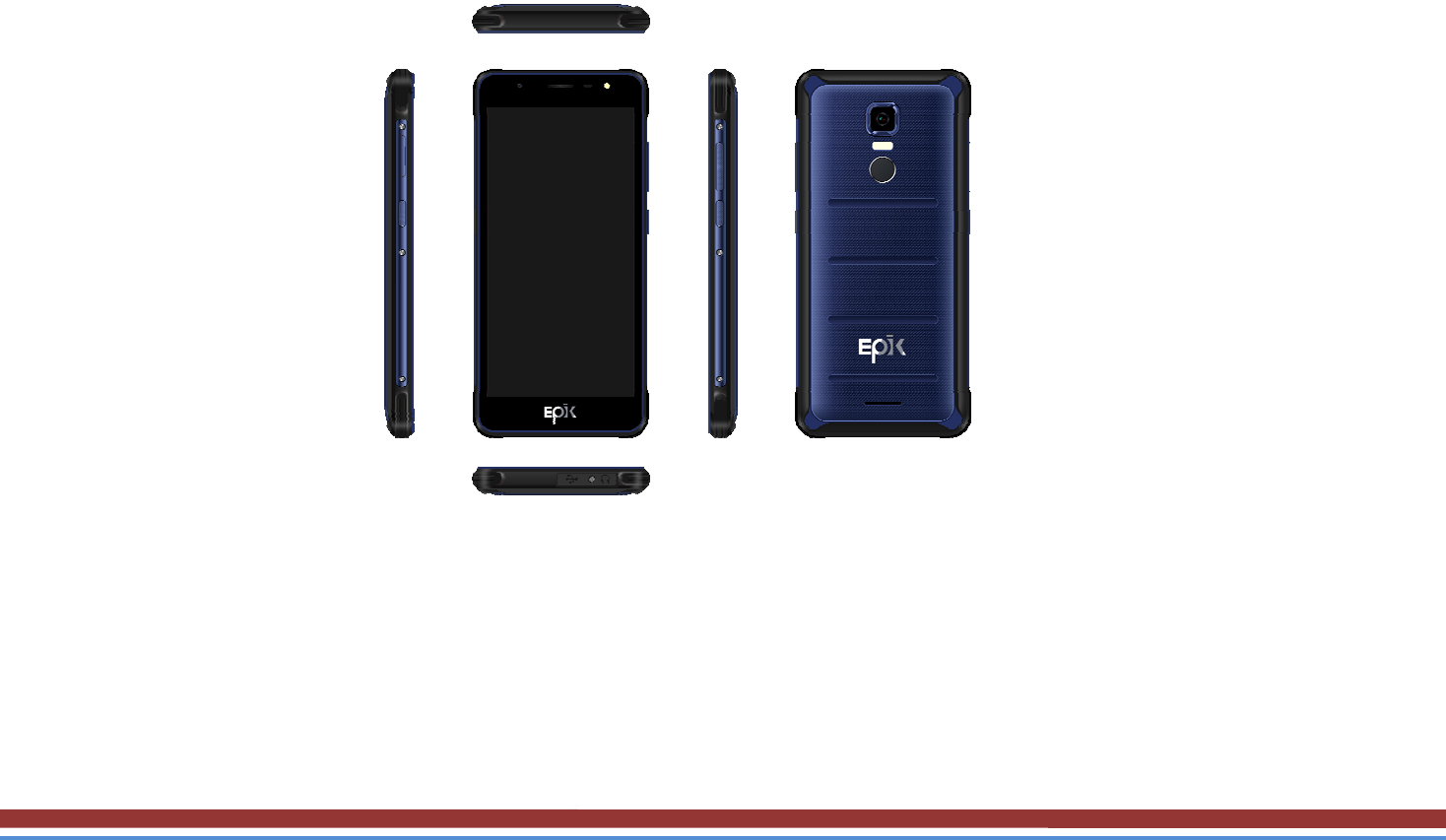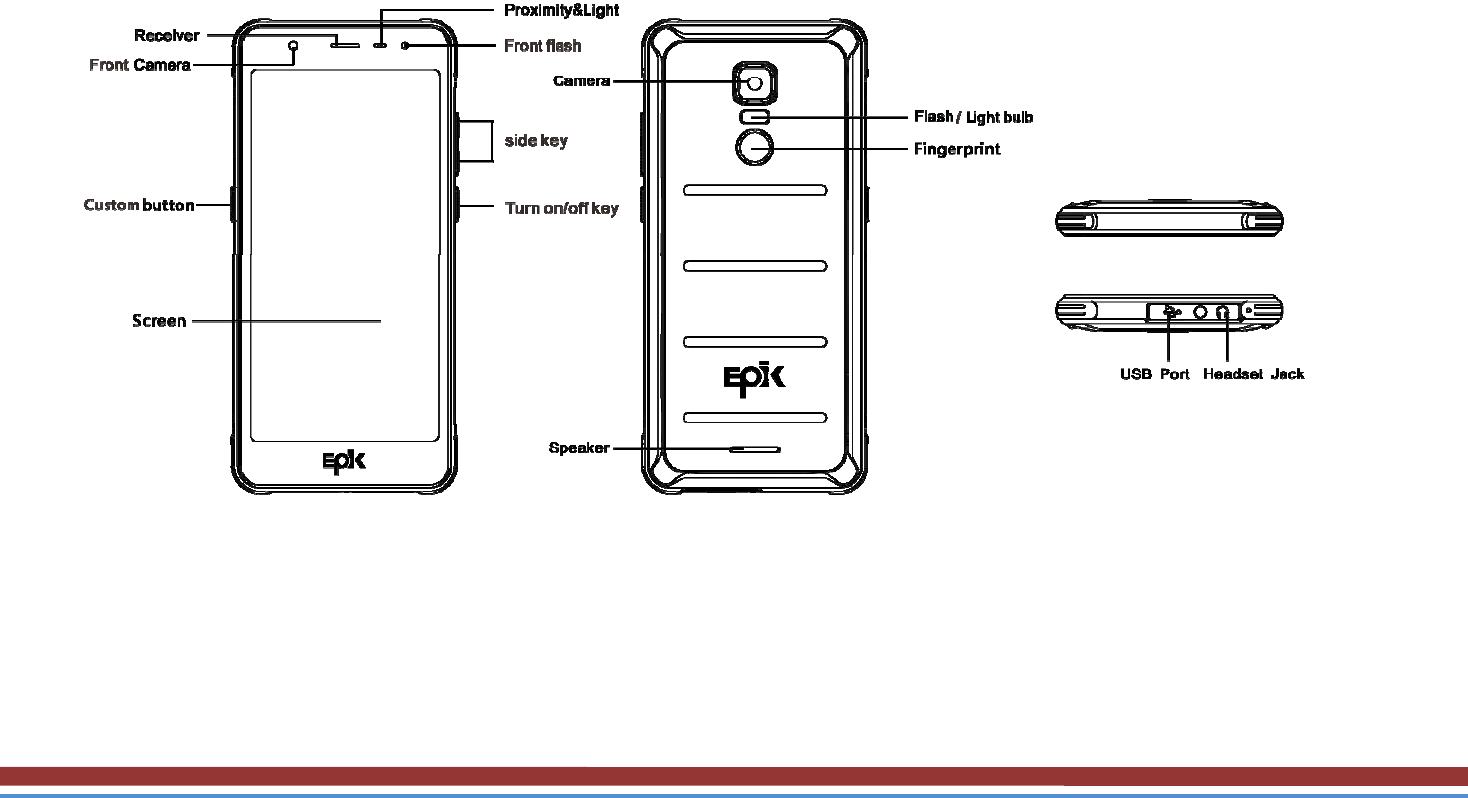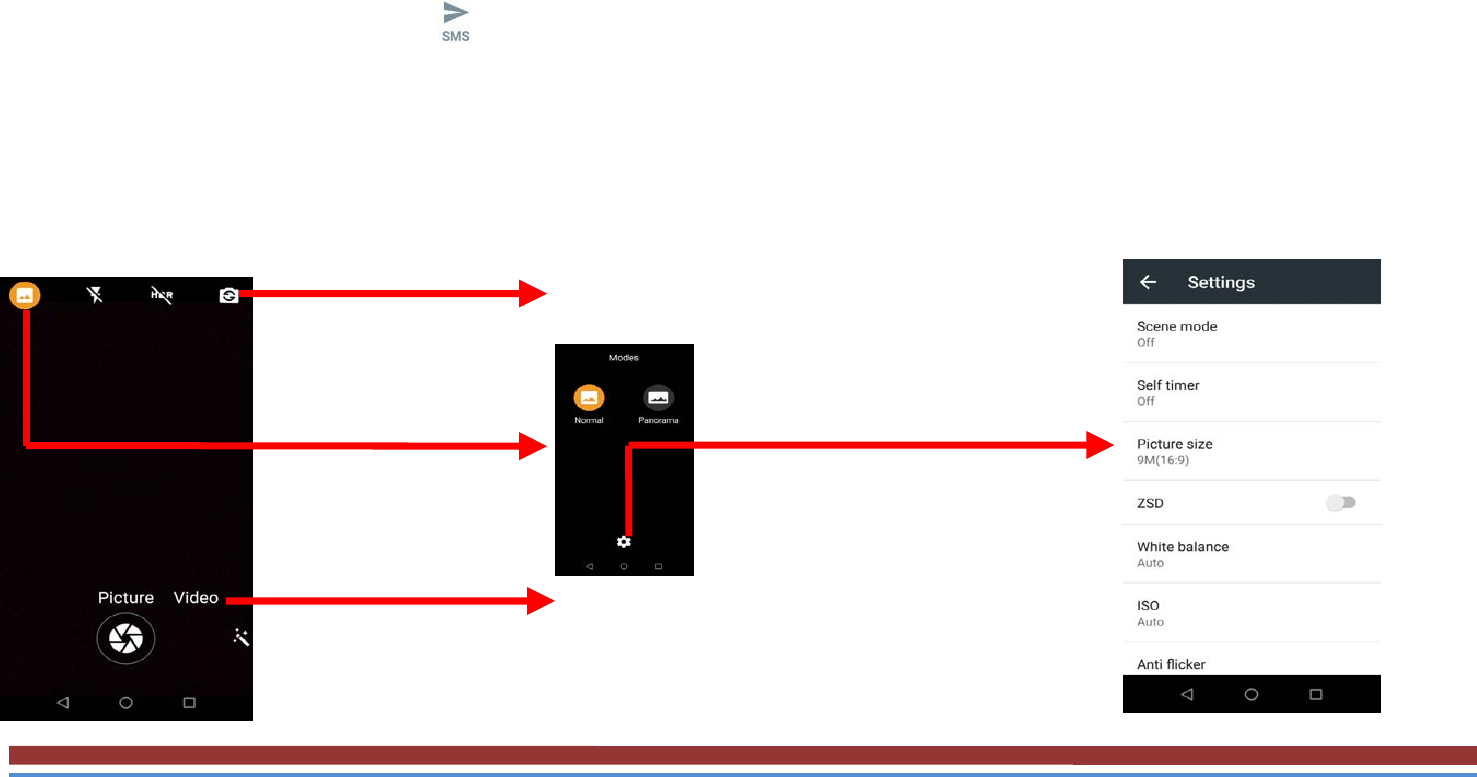Epik One America RS550 Smart Phone User Manual
Epik One America Corporation Smart Phone
Contents
- 1. User manual
- 2. User Manual
User Manual

1. Using this manual
Thank you for choosing this mobile device.
This device will provide you with high-quality mobile communication and entertainment based
on exceptional technology and high standards.
This manual has been specially designed to guide you through the functions and features of your
device.
1.1 Read me first
●Before using your device,read the entire manual and all safety instructions to ensure safe and
proper use.
●The descriptions in this manual are based on the default settings of your device.
●The images and screenshots used in this manual may differ from the actual product.
●The contents of this manual may differ from the product, or from software provided by service
providers or carriers, and are subject to change without prior notice.
●Available features and additional services may vary by device, software, or service provider.
●Formatting and delivery of this manual is based on Android operating systems and may vary
depending on the user’s operating system Version.
●Applications on this device may perform differently from functions available in the computer
version of the operating system.

2. Assembling
2.1 General information
The phone is a dual SIM phone that encloses features, such as Android version 8.1 Oreo,
Wi-Fi.etc. This phone is provided with two SIM slots for two different SIM cards. The SIM card
inserted in the slot1 is called SIM1, and the other one in the slot2 is known as SIM2. You can
select to operate SIMs as per your needs.

2.2 Phone Overview

2.3Insert the SIM card
Insert the SIM card when you need a cellular service. Do not insert a Memory card into the SIM
card slot.
2.4 Charge the battery
Before using the device for the first time or when the battery has been unused for an extended
period, you must fully charge the battery.
●Use only our approved chargers and cables. Unapproved chargers or cables may cause batteries
to explode or damage your device.
2.5 Insert a Memory card
Your device accepts Memory cards. Memory cards with maximum capacities of 64 GB,When
you insert a Memory card into your device, the Memory card’s file directory will appear in the
Memory card folder.
3. Getting started
3.1 Turn on or off your device
Press and hold the Turn on/off key.
3.2 Use the touch screen
Your device’s touch screen lets you easily select items or perform functions. Learn basic actions
for using the touch screen.

3.3 Lock or unlock the touch screen and the keys
Your device will go in standby mode when you do not use it for a specified period. To turn on the
screen, press the Turn on/off key.
●to set standby time, select Settings →Display →Sleep.
3.4 Get to know the Home screen
From the Home screen, you can view your device’s status and access applications.
The Home screen has multiple panels. Scroll left or right to view the panels on the Home screen.
Move an item on the Home screen
Tap and hold an item, and then drag it to a new location.
3.5 Access applications
Launch applications and take full advantage of features on your device. You can reorganize the
application list to match your preferences, or download applications from the Internet to enhance
your device’s functionality.
3.6 Launch multiple applications
Your device allows you to multitask by running multiple applications at the same time. To launch
multiple applications, select another application to launch from the Home screen.

4. Communication
4.1 Calling
Make a call
1 In the application list, select Phone →Keypad, and then enter an area code and a phone number.
2 Select to make a voice call.
3 Select to end the call.
Answer a call
1 During an incoming call, Select and swipe up to answer the call, Press the side key to mute
the ringtone.
2 Select to end the call.
4.2 Messages
Learn to create and send text (SMS) or multimedia (MMS) messages, and view or manage
messages that you have sent or received.
Send a text message
1 In the application list, select Messaging →
2 Add recipients:

●Enter phone numbers manually and separate them with a semicolon or a comma.
●Select phone numbers from your contact lists.
3 Select the text field and enter your message text.
4 To send the message, select
5. Entertainment
5.1 Camera
Learn how to take and view photos and videos. You can take photos and record videos.
Tap this icon to switch to video
record
Tap this icon to
switch to front camera
Tap this icon to
o
p
en settin
g
menu

Take a photo
1 In the application list, select Camera.
2 Aim the camera lens at the subject and make
3 Select to take a photo.
The photo is saved automatically.
Record a video
1 In the application list, select Camera.
2 Aim the lens at the subject and make any necessary adjustments.
3 Select to start recording.
5.2 Music player
Learn to listen to your favorite music while on the go.
Add music files to your device
Start by transferring files to your device or memory card:
● Download from the internet.
● Download from a computer with Windows Media Player.
● Receive via Bluetooth.
● Copy audio files to your Memory card.
Play music

1 In the application list, select Play Music.
2 Select a music category → a music file.
6. Tools
6.1 Calculator
Learn to perform calculations with your device.
Perform a calculation
1 In the application list, select Calculator.
2 Use the keys on the screen to perform basic calculations.
6.2 Clock
Set an alarm
1 In the application list, select Clock →Alarm.
2 Select add alarm.
3 Set the details of the alarm.
4 When you are finished, select OK.
Stop an alarm
When the alarm sounds,
●To stop the alarm, select Dismiss
●To silence the alarm for the snooze period, select Snooze.

6.3 Calendar
You can open Calendar to view and manage the events you have created. Touch Menu icon do the
following operations: New event, Refresh, Search, Calendars to display and Settings.
7. Settings
Access the setting options
1 In the application list, select Settings.
2 Select a setting category, and then select an option.
8. Connectivity
8.1 Wi-Fi
You can connect to the Internet or other network devices anywhere an access point or wireless
hotspot is available.
Activate the Wi-Fi feature
In the application list, select Settings and then drag the Wi-Fi switch to the right.
The Wi-Fi feature running in the background will consume battery power. To preserve battery
power, activate the feature only when needed.

Find and connect to a Wi-Fi AP
1 In the application list, select Settings →Wi-Fi.
Your device searches for available Wi-Fi APs automatically.
2 Select an AP.
3 Enter the password for the AP (if necessary).
4 Select Connect.
Add a Wi-Fi AP manually
1 In the application list, select Settings →Wi-Fi →Add network.
2 Enter an SSID for the AP and select a security type.
3 Set the security settings according to the security type you selected, and then select Save.
8.2 Bluetooth
The Phone support Bluetooth, You can use this function to send media file.
Activate the Bluetooth feature
1 In the application list, select Settings →Bluetooth
2 Select a device.
3 Select OK to match the Bluetooth PIN between two devices. Alternately, enter a Bluetooth PIN
and select OK.

Send data via Bluetooth
1 Select a file or item from an appropriate application.
2 Select an option for sending data via the Bluetooth feature.
The method for selecting an option may vary by data type.
3 Search for and pair with a Bluetooth device.
Receive data via Bluetooth
1 In the application list, select Settings→Bluetooth and then select the tick box next to your
device.
To select the length of time that your device will be visible, press the Option key and select
Visible time out.
2 When prompted, select OK to match the Bluetooth PIN or enter the Bluetooth PIN and select
OK (if necessary).
3 Select Accept to confirm the connection between two devices.
8.3 NFC
The Phone support NFC (Near Field Communication), The NFC adopts bidirectional recognition
and connection, and NFC phones have three functional modes :NFC phones as reading devices
(readers), NFC phones as reading devices (card simulation), and point-to-point communication
applications between NFC phones.

9. E-waste disposable mechanism
'E-waste' means waste electrical and electronic equipment (WEEE). In other words E-waste is a
popular, informal name for electronic products nearing the end of their "useful life".
Do’s and Don’ts for disposal e-waste
Do’s:
a. Ensure that an Authorized Person repairs your products
b. Call Our Local Authorized Collection Centers to Dispose products.
c. Always drop your used electronic products, batteries or any accessories thereof after the end
of their life at nearest Authorized Collection Point or Collection Center.
d. Separate the packaging material according to responsible waste disposal options and sorting
for recycling.
e. Always remove the battery from the product, when you do not intend to use the product
anymore it in future.
Don’ts:
a. Do not Dismantle your product on your own.
b. Do not give your e-waste to Scrap Dealer/ Rag Pickers.
c. Do not dispose-off the e-waste in landfills.
d. Never dump E-waste in garbage bins.
e. Do not dispose of your product at municipal waste bins or rooms.

f. Do not throw used batteries into household waste.
g. Consequences of improper handling and disposal of E-Waste.
10. FCC Warning
This device complies with part 15 of the FCC Rules. Operation is subject to
the following two conditions:
(1) This device may not cause harmful interference, and
(2) this device must accept any interference received, including interference
that may cause undesired operation.
Any Changes or modifications not expressly approved by the party
responsible for compliance could void the user's authority to operate the
equipment.

Note: This equipment has been tested and found to comply with the limits for
a Class B digital device, pursuant to part 15 of the FCC Rules. These limits
are designed to provide reasonable protection against harmful interference in
a residential installation. This equipment generates,uses and can radiate radio
frequency energy and, if not installed and used in accordance with the
instructions, may cause harmful interference to radio communications.
However, there is no guarantee that interference will not occur in a particular
installation. If this equipment does cause harmful interference to radio or
television reception, which can be determined by turning the equipment off
and on, the user is encouraged to try to correct the interference by one or more
of the following measures:
—Reorient or relocate the receiving antenna.

—Increase the separation between the equipment and receiver.
—Connect the equipment into an outlet on a circuit different from that to
which the receiver is connected.
—Consult the dealer or an experienced radio/TV technician for help.
Specific Absorption Rate (SAR) information:
SAR tests are conducted using standard operating positions accepted by the
FCC with the phone transmitting at its highest certified power level in all
tested frequency bands, although the SAR is determined at the highest
certified power level, the actual SAR level of the phone while operating can
be well below the maximum value. Before a new model phone is a available
for sale to the public, it must be tested and certified to the FCC that it does not

exceed the exposure limit established by the FCC, tests for each phone are
performed in positions and locations(e.g. at the Limb and worn on the body),
as required by the FCC. For body worn operation, this model phone has been
tested and meets the FCC RF exposure guidelines when used with an
accessory designated for this product or when used with an accessory that
contains no metal and that positions the handset a minimum of 10mm from
the body. Non-compliance with the above restrictions may result in violation
of RF exposure guideline.